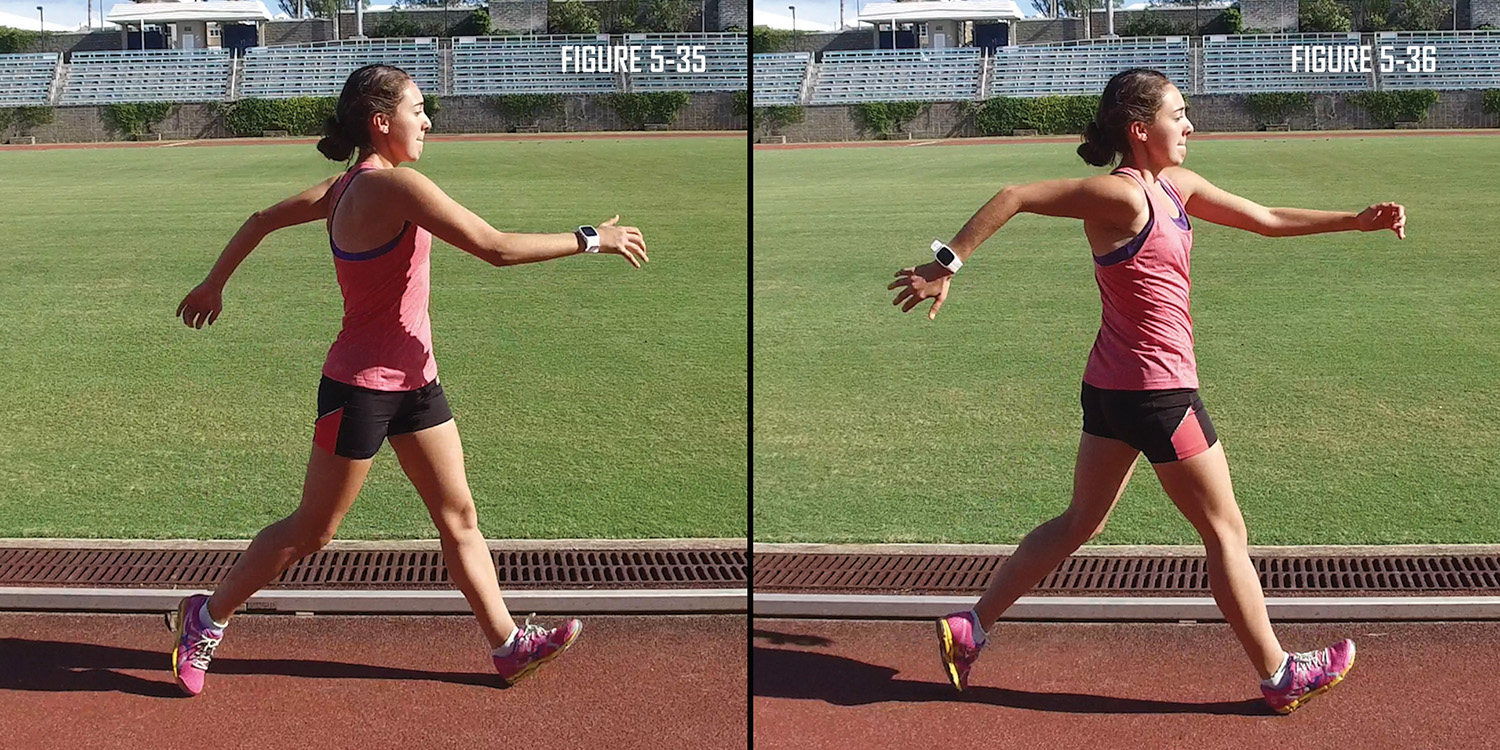
Overstriding in front of your body (Figure 12-1) makes it difficult to walk efficiently and can lead to the perception that you’ve lost contact with the ground. A tight hip flexor causes the rear foot to lift off the ground prematurely and shortens the stride where you want it the longest. In addition, overstriding may be caused due to poor arm swing or just overly zealous effort (usually when you are tired and muscling through). Observe how much better Miranda looks in Figure 12-2 where she is walking with an appropriate stride length.


Work on shortening your arm swing so that the hands come back to at most 4 to 6 inches behind the hips. The arms, hips, and legs all move in rhythm and are proportional. A decrease in arm swing should reduce your stride length. Some people incorrectly profess that the peak of the upper arm’s range of motion should be when the upper arm is parallel to the ground. Instead, the peak of the upper arm’s range of motion should come when the upper arm swings backward coming up to an angle of 20-30 degrees (See chapter 4, page 20.)

Often overstriding in front of the body is caused by a lack of forward hip rotation. Concentrate on driving your hip forward to reduce the percentage of your stride that is in front of your torso.

The first 10% of the stride is most important. It’s what helps differentiate a race walker from a speed or health walker. It focuses on heel strike with the toe pointed up. We call it the Foot Plant drill and you must master it before progressing forward.
Steps
- Start by standing with your weight on your rear foot (Figure 3-3).
- Swing your other leg forward (Figure 3-4) from the knee until it fully extends.
- As you do, land with your foot slightly in front of the body, with your toes up and the knee straightened (Figure 3-5).
- Transfer all your weight to that leg (Figure 3-6).
- While virtually standing in place, rock back and forth from one foot to the other emphasizing the heel strike.
- Note that the knee does bend when you rock back.
- Repeat this exercise for both legs.


The Hip Flexor – Lunge Forward stretch is great for working on tight hip flexors which inhibit proper forward hip rotation.
Body Position
Place your right knee on the ground with your right foot extended behind you. Place your left foot on the ground in front of you, making sure the left knee stays behind the ankle.
Steps
- With a straight back, lunge forward and feel the stretch in your right hip flexor (Figures 9-10 & 9-11).
- Hold for 20-30 seconds.
- Repeat 2-3 times on each side.
- For an advanced stretch, raise both your hands while keeping your back in a vertical position (Figure 9-12).


Tight hip flexors inhibit proper forward hip rotation.
Body Position
Kneel on the ground, preferably soft ground.
Steps
- Place your left leg in front of the body while bending at the knee.
- Lower your torso, using your hands for support.
- Slide the right leg back and lower your torso all the way down so that your forearms are supporting your body weight.
- Feel the stretch across your right hip flexor and left piriformis.
- Hold for 20-30 seconds.
- Repeat 2-3 times for each side.


If you are swaying to the side instead of driving your hip forward, resynchronize your hips by doing the Long Strides – Long Arms drill.
An improvement in forward hip rotation is likely to improve your ability to straighten the knee on impact and keep it straightened until your leg passes the vertical position. When your hips rotate forward, the amount of your stride in front of your torso is reduced, thus reducing the likelihood that your leg bends as you ride forward on it. Therefore, the Long Strides - Long Arms drill and any other drills that target improved forward hip rotation are very useful to avoid bent-knee issues.
Body Position
Perform this exercise while race walking.
Steps
- Keeping both arms straight and your hands flat with your palms back, race walk with an exaggerated stride by driving your hips forward (Figures 5-35 & 5-36).
- Perform this exercise for 30 meters. You should feel a connection between your arms and hips.


There are four variations of Quick Step drills that help to increase your speed, increase your turnover rate, and reduce overstriding. In addition, these drills allow you to practice getting your toes up. They also force you to straighten your knee as quickly as possible. Each variation follows the same basic steps.
Body Position
Race walk with normal leg technique.
Steps
- Walk with very short strides of 12 inches or less.
- Focus on turnover, forcing your feet to pick up and come down very quickly (Figures 7-6 through 7-8).
- Focus on planting with your heel, landing with your toe up, and rolling through smoothly.
- Focus on quieting your shoulders and torso.

The first two versions of Quick Steps are to place your Hands Behind the Back (Figure 7-9) or to place your Hands Behind Your Head (Figure 7-10). This causes the hips to be forced to move without the aid of the arms pumping forward and back, thus also helping you develop forward hip rotation.
You can also try the Superman variation (Figure 7-11) where you place your hands out in front of your body and keep your head held as steady as possible. Excessive movement of the head could cause judges to think that you are lifting. Therefore, this is good practice not only for our feet, but also for our head.
A final variation of Quick Steps is the Airplane (Figure 7-12) where you place your hands out to your sides. This helps with turnover and forward hip rotation.
